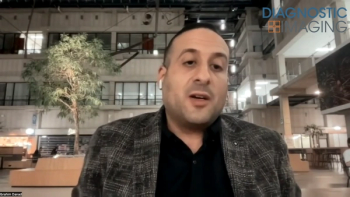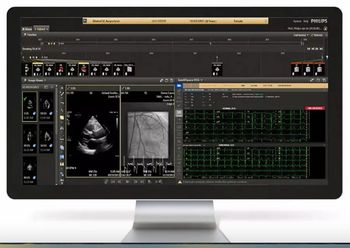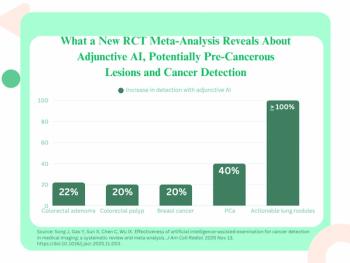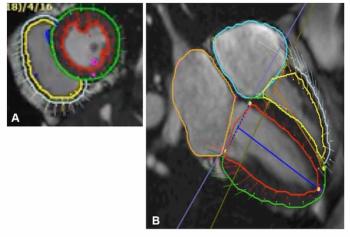
CTA AI Tool for Cerebral Aneurysm Detection “Advances the Field”
Deep learning tool improves cerebral aneurysm detection, specifically among radiologists with fewer years’ experience.
A new artificial intelligence (AI) tool has been shown to help radiologists better detect cerebral aneurysms on CT angiography (CTA) scans, potentially leading to faster detection and improving patient outcomes.
Cerebral aneurysms are responsible for between 80 percent-to-90 percent of all non-traumatic subarachnoid hemorrhages – up to half of which are fatal, and 10 percent-to-20 percent of which lead to permanent disability. Consequently, being able to catch these aneurysms prior to rupture is critical, said a team from Tongji Medical College’s Union Hospital in Wuhan, China.
To reach this goal, the team, led by Xi Long, Ph.D., from the Union Hospital radiology department, created a 3D-detection algorithm based on a convolutional neural network. They published and discussed the results of their work in the Nov. 3
“We introduced a highly sensitive deep learning-based algorithm for automated detection of cerebral aneurysms on CT angiography images,” Long said. “Radiologists’ performance in detecting aneurysms improved with the aid of the algorithm, especially for less experienced radiologists.”
Related Content:
CTA is highly accurate and is already the first choice for evaluating cerebral aneurysms, but its shortcoming is that it can frequently leave smaller aneurysms undetected. Researchers have been working for several years to develop an AI tool that can help pinpoint those aneurysms, but the studies have not reached expectations because they have relied on too few CT scans with identified aneurysms or they did not include a variety of aneurysms.
The tool developed by Long’s team overcame these obstacles, but radiologists from the Mayo Clinic urged others in the industry to refrain from thinking this algorithm is the Holy Grail that can finally push aneurysm detection into the AI era.
“The study by [Long’s team] advances the field, given its large size and external validation,” said David F. Kallmes, M.D., Mayo professor of radiology and neurosurgery, and Bradley J. Erickson, M.D., Ph.D., Mayo professor of radiology and informatics, in an accompanying
Still, the results from Long’s study revealed their AI tool can be beneficial, particularly to radiologists who have fewer years’ experience. To develop their tool, they used a training set of CT angiograms from 534 patients that included 688 cerebral aneurysms – 649 saccular and 39 fusiform aneurysms. Aneurysm size ranged from 1.2 mm to 45.6 mm, and the average size was 5.3 mm.
In addition, their validation set also included 534 patients with 649 cerebral aneurysms – 626 saccular and 23 fusiform. Aneurysm size in the validation set ranged from 1.2 mm to 30.8 mm, and the average size was 5.2 mm. They also included an additional external validation set of 400 CT angiograms that included 206 aneurysms – 193 saccular, 13 fusiform – from the same hospital captured with the same CT scanners.
Overall, the team determined, their algorithm detected 633 of the 649 cerebral aneurysms, reaching a sensitivity of 97.5 percent. Specifically, sensitivities for saccular and fusiform aneurysms were 97.6 percent and 95.7 percent, respectively, with the sensitivity gradually increased, reaching 100 percent in aneurysms of 10 mm or larger. The tool also identified eight aneurysms that had been overlooked during the initial assessment. Six of these aneurysms were smaller than 3mm, and two were between 3mm and 5mm.
“The developed deep-learning system has shown excellent performance in detecting aneurysms,” Long said. “We found some aneurysms that were overlooked by the human readers on initial reports, but they were successfully depicted by the deep-learning system.”
The statistical analysis, Long said, showed that using AI can augment a radiologist’s performance – and those who were less experienced saw the most benefit. The outcomes show the algorithm could be a support tool, potentially as a second opinion during CTA angiography. It can be particularly helpful since the algorithm cannot be influenced by experience level, the length of a work shift, or a provider’s mood.
However, the team acknowledged, their algorithm did have a high rate of false-positive findings per case of 13.8, making revisions from human readers necessary. And, it is that limitation that Kallmes and Erickson found most worrisome, limiting the utility of the tool.
“At best, this proposed algorithm is an interpretation aid rather than a diagnostic aid,” they said.
The algorithm also has other limitations, Long said. It is possible that it can miss very small aneurysms or ones that are situated to structures with similar density, such as bones. And, more assessments with multi-centric external data, such as images from around the world, should be conducted to more accurately determine the algorithm’s generalizability.
Given these results and the current limitations, Long’s team agreed with Kallmes' and Erickson’s assessment of what the algorithm is able to do.
“Simply put, the deep-learning system is intended to assist human readers, not to replace them. At this time, the role of this deep-learning system, which has been trained to recognize aneurysms, is to give suggestions to the human reader to improve their performance and reduce mistakes,” Long said. “The combined work of the human reader and computer system improves the diagnostic accuracy for the patient’s sake.”
For more coverage based on industry expert insights and research, subscribe to the Diagnostic Imaging e-Newsletter
Newsletter
Stay at the forefront of radiology with the Diagnostic Imaging newsletter, delivering the latest news, clinical insights, and imaging advancements for today’s radiologists.



























